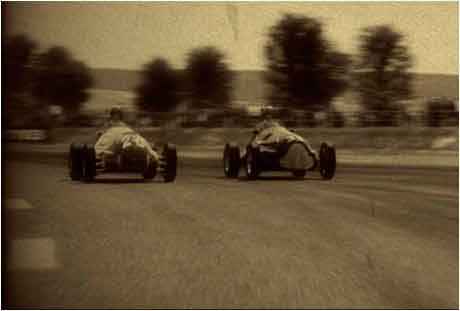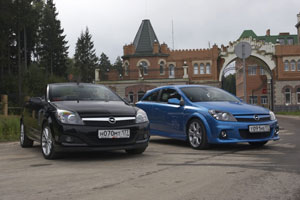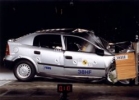Test drive Opel Astra Sedan 1998 - 2008 Sedan
Opel Astra
 Opel Astra new generation attracts not only an original design. The car has become more dynamic and comfortable and pleases with excellent controllability. And some solutions related to the use of advanced technologies are more characteristic of premium models, but not for compact cars.
Opel Astra new generation attracts not only an original design. The car has become more dynamic and comfortable and pleases with excellent controllability. And some solutions related to the use of advanced technologies are more characteristic of premium models, but not for compact cars. Premiere on Riviera
Saint -Tropez is one of the most remarkable places in the Mediterranean coast. The former fishing village, which served as a source of inspiration for many artists, has turned into a resort worldwide today. There are many entertainment institutions and expensive villas, the rent of which will cost at least 200 thousand euros per month, and landscapes amazing imagination - azure sea, blue sky and white sand. Saint-Trope, no doubt, a very successful place for the tests of the new Astra, in the preparation of the production of which more than 1 billion euros were invested.
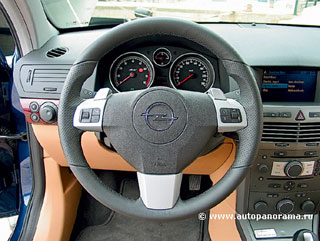 The choice of a car from the gamut by the organizers of the new Astra is akin to the lottery: 5-door hatchbacks of three colors with different interior design and eight different engines- from 1.4 Twinport Ecotec to 1.9 CDTI, and in addition, different transmission options- 5- and 6-speed Mechanical gearboxes, a 4-band automaton and Easytronic. I got a golden car with a diesel engine. In March, when the season of outdoor activities is still ahead and there are not so many cars on the roads, a car that reflects the rays of the heating sun that was already in a completely summer sun. Ahead we had a route laid along the picturesque surroundings of Saint-Tropez, and the next day we were waiting for arrivals at one of the private airfields.
The choice of a car from the gamut by the organizers of the new Astra is akin to the lottery: 5-door hatchbacks of three colors with different interior design and eight different engines- from 1.4 Twinport Ecotec to 1.9 CDTI, and in addition, different transmission options- 5- and 6-speed Mechanical gearboxes, a 4-band automaton and Easytronic. I got a golden car with a diesel engine. In March, when the season of outdoor activities is still ahead and there are not so many cars on the roads, a car that reflects the rays of the heating sun that was already in a completely summer sun. Ahead we had a route laid along the picturesque surroundings of Saint-Tropez, and the next day we were waiting for arrivals at one of the private airfields.  Dynamics, comfort ...
Dynamics, comfort ... The appearance of the previous Astra never caused me delight, but otherwise it was a good and solid car. But the design of the new model can be called a breakthrough. The image of the Opel Astra is primarily dynamics, ”says the project manager Uliter. - The character of this car can not be mentioned, it is clearly read in its rapid shape. But the third generation Astra is very different from its predecessor, and from its immediate competitors not only externally. Inside, the 5-door hatchback significantly added to volume, especially the passengers of the rear seat will feel. Even a tall person who crossed the driver’s seat from the seat of the rear passenger does not seem closely. The car base is increased to 2.61 m, the legs are 17 mm larger, and 35 mm increased above the head. True, the knees are a little high, but they do not rest on the back of the front seat. The length of the new Astra has increased compared to the predecessor by 140 mm and now is 4249 mm. This is 40 mm more than the longest of the three of the three musketeers - VW Golf, Ford Focus and Renault Megane.
 The manufacturer offers fifteen different options for finishing the cabin, and its interior is in perfect harmony with the external design of the car. A convenient three -spoke steering wheel, a steering column, adjustable both in height and in the corner of inclination, seats with lateral support. If you remove the armrest located between the front seats, into which you rest your elbow when driving, then the driver’s landing does not interfere more. The temperature in the cabin is controlled by the electronic climate control system, for which you can order an air quality sensor and automatic inclusion of the recirculation mode as options. The readings of the devices are easily read, and the navigation system using a display size of 14.3x7.9 cm indicates us the right path - in this case along the coast of the Mediterranean Sea.
The manufacturer offers fifteen different options for finishing the cabin, and its interior is in perfect harmony with the external design of the car. A convenient three -spoke steering wheel, a steering column, adjustable both in height and in the corner of inclination, seats with lateral support. If you remove the armrest located between the front seats, into which you rest your elbow when driving, then the driver’s landing does not interfere more. The temperature in the cabin is controlled by the electronic climate control system, for which you can order an air quality sensor and automatic inclusion of the recirculation mode as options. The readings of the devices are easily read, and the navigation system using a display size of 14.3x7.9 cm indicates us the right path - in this case along the coast of the Mediterranean Sea. 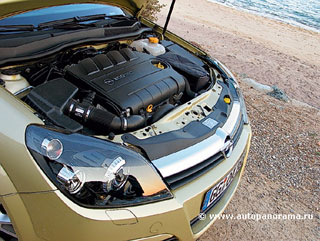 ... and modern technologies
... and modern technologies Astra not only looks dynamic - she is so by nature. For the new car, a double-leaf rear suspension was re-designed with a torsion-shaped U-shaped beam increased from 60 to 70 mm diameter. Moreover, the suspension settings are different depending on the type of body and engine. The developers decided not to complicate the design of the rear axle with a multi -link suspension, as, for example, in VW Golf and Ford Focus. As a result, the suspension turned out to be very compact, with a minimum weight and at the same time with excellent characteristics. Thanks to this, there was an additional space for the rear passengers, and the controllability and stability of the car did not worsen at all. The new Opel, shod in tires of 205/55 R16, holds the way perfectly, and even riding in an aggressive style does not cause unpredictable reactions of a superbly -minded chassis.
 A lot to the image of the new Astra adds the use of advanced technologies. A couple of years ago, it was difficult to believe that an adaptive system of the head lighting AFL will be installed on a small middle class car, changing the direction of the headlight of the headlights depending on the position of the steering wheel, a monitor that allows you to control the pressure in each wheel, and the adaptive IDS system with continuous control Damping CDC, changing the characteristics of the chassis. If you turn on the sports mode by pressing the Sport button on the front panel, the clearance will decrease by 15 mm, and the suspension settings will change, it will become more rigid. The characteristics of the steering are also adapted and the sharpness of the reaction of the car to press the gas pedal will increase. Moreover, all these changes are felt instantly.
A lot to the image of the new Astra adds the use of advanced technologies. A couple of years ago, it was difficult to believe that an adaptive system of the head lighting AFL will be installed on a small middle class car, changing the direction of the headlight of the headlights depending on the position of the steering wheel, a monitor that allows you to control the pressure in each wheel, and the adaptive IDS system with continuous control Damping CDC, changing the characteristics of the chassis. If you turn on the sports mode by pressing the Sport button on the front panel, the clearance will decrease by 15 mm, and the suspension settings will change, it will become more rigid. The characteristics of the steering are also adapted and the sharpness of the reaction of the car to press the gas pedal will increase. Moreover, all these changes are felt instantly. On serpentines, the steering mechanism, coupled with perfectly selected suspension characteristics, demonstrate excellent clarity of work.
 And let the feedback on the steering wheel due to an electrolyword amplifier is a little rather weak, the car reacts impeccably to the driver’s commands. In sports mode, the car practically does not roll in turns, but rare irregularities on the road make themselves felt.
And let the feedback on the steering wheel due to an electrolyword amplifier is a little rather weak, the car reacts impeccably to the driver’s commands. In sports mode, the car practically does not roll in turns, but rare irregularities on the road make themselves felt. The turbodiesel 1.9 CDTI with a capacity of 150 hp is no less pleasing. at 4000 rpm and a torque of 315 nm at 2000 rpm. Together with a mechanical 6-speed gearbox and an adaptive suspension, this is a very successful combination. And if you compare the acceleration time to a hundred, then the new Astra with the 1.9 CDTI engine accelerates in 9.1 s, that is, only 0.2 C is slower than Astra with gasoline 2.0 Turbo. At the same time, the fuel consumption in diesel Opel, as the manufacturer promises, does not exceed 5.6 liters per 100 km in a mixed cycle. It is not surprising that diesel engines in Europe strengthen their positions, especially in the class of compact cars. Our situation is different, so gasoline versions will be delivered to Russia first of all.
 Having traveled to the Astra diesel version a little more than a hundred kilometers, I moved to a car with a 1.6-liter TwinPort Ecotec gasoline engine and EasyTronic transmission. Twinport cunning technology allows using the adjustable throttle valve in each of the two inlet channels of the cylinder to achieve the optimal quality of the combustible mixture, which leads to an increase in power by 3% and a decrease in fuel consumption by 10%. The average gasoline consumption declared by the manufacturer for the version with such a motor is 6.6 liters per 100 km in a mixed movement cycle.
Having traveled to the Astra diesel version a little more than a hundred kilometers, I moved to a car with a 1.6-liter TwinPort Ecotec gasoline engine and EasyTronic transmission. Twinport cunning technology allows using the adjustable throttle valve in each of the two inlet channels of the cylinder to achieve the optimal quality of the combustible mixture, which leads to an increase in power by 3% and a decrease in fuel consumption by 10%. The average gasoline consumption declared by the manufacturer for the version with such a motor is 6.6 liters per 100 km in a mixed movement cycle. This version has one of the richest sets among the cars provided for test. The salon is finished with pleasant light skin, and all the charms of the IDS adaptive system complement the 5-band EasyTronic transmission. In Sport mode, such a transmission allows you to use the high engine speeds more widely, in addition, the transmission can be switched by the keys on the steering wheel, however, only with an increase. The HSA function has been added to the possibilities of the transmission (assistance when touched from the rise in the rise), which prevents the car back and gives the driver one and a half seconds in order to move.
The gasoline engine did not seem very frisky, especially after a temperamental diesel. Still, because the 1.6-liter engine develops the power of not 150, but 105 hp, and as for the torque, it is generally half as much. The long -awaited 150 nm manifest only at 3900 rpm. True, the pressing of the Sport button changes the situation for the better: the motor faster faster. Nevertheless, this version is more suitable for driving around the city than along suburban routes.
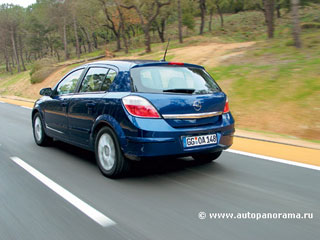 The smartest in class
The smartest in class Undoubtedly, the new Astra is a worthy successor of the traditions of its family and in terms of comfort and security is in no way inferior to its competitors. The third generation of Astra is, first of all, the dynamics and implementation of solutions related to advanced technologies. None of the classmates can today offer AFL system that changes the direction of the headlight of headlights depending on the angle of rotation of the steering wheel, and the electronic adaptive suspension. Another question is, how justified are these mind games in a car of this class? In Europe, the market segment, which is Astra, accounts for approximately 30% of the sales of all cars. In addition, the compact minivans Zafira and Meriva include the same segment.
The production of the new Astra is deployed in three factories - in Belgium, Great Britain and Germany. Astra sales with a hatchback body began on March 22, the price of the base version with a 1.4-liter gasoline engine is 15,200 euros, but even before the start of sales in Europe, about 30 thousand orders were accepted. In the summer, the most charged version of Astra will enter the European market: the new hatch-bek, in addition to the smart chassis, will receive a 2-liter turbo engine with a capacity of 220 hp. In Russia, the first cars will appear in May. Most likely, these will be gasoline versions with 1.6 and 1.8 liter engines, which will include a full -size reserve.
Some technical characteristics of Opel Astra 1.6 Twinport EcoteC
(manufacturer data)
Dimensions, mm 4249x1753x1460
Equipped mass, kg 1230
Base, mm 2614
Diameter of the turn, m 10.6
Engine type gasoline 4-cylinder
Working volume, cubic meter. cm 1598
Max. Power, L.S./rpm 105/6000
Max. moment, nm/rpm 150/3900
The transmission is automatic 5-band
EASYTRONIC
Tires 205/55 R16
Max. Speed, km/h 185
Acceleration time 0-100 km, with 12.3
Fuel consumption, l/100 km
on the mixed cycle 6.6
Tank volume, l 52
Vadim Ovsyankin
Photo by the author and the manufacturer
Source: Avtopanorama magazine
Test drive Opel Astra Sedan 1998 - 2008
Crash Test Opel Astra Sedan 1998 - 2008
Krassh Test: Detailed Information25%
Driver and passengers
7%
Pedestrians




